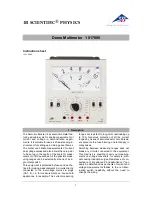
250V MAX
15A MAX
FUSED
COM
DC
15A
OFF
200
20
2
DC V
200
m
20M
200
K
20K
2K
200
8CYL
6CYL
TACH
X10
5CYL
4CYL
8CYL
6CYL
5CYL
4CYL
DWELL
DUTY
CYCLE
%
OHMS
°
15
A
28
Testing Engine Sensors
In the early 1980’s, computer controls were installed in vehicles to meet Federal Government
regulations for lower emissions and better fuel economy. To do its job, a computer-controlled
engine uses electronic sensors to find out what is happening in the engine. The job of the sensor
is to take something the computer needs to know, such as engine temperature, and convert it to
an electrical signal which the computer can understand. The digital multimeter is a useful tool for
checking sensor operation.
Oxygen (O
2
) Type Sensors
The Oxygen Sensor produces a voltage or
resistance based on the amount of oxygen in
the exhaust stream. A low voltage (high resis-
tance) indicates a lean exhaust (too much
oxygen), while a high voltage (low resistance)
indicates a rich exhaust (not enough oxygen).
The computer uses this voltage to adjust the
air/fuel ratio. The two types of O
2
Sensors
commonly in use are Zirconia and Titania.
Refer to illustration for appearance differ-
ences of the two sensor types.
Test Procedure (see Fig. 30):
1. If engine is HOT, let it COOL down be-
fore proceeding.
2. Remove Oxygen Sensor from vehicle.
3. Insert BLACK test lead into COM test
lead jack.
4. Insert RED test lead into
test
lead jack.
Titania-Type
Oxygen Sensor
Zirconia-Type
Oxygen Sensor
Exposed
flat element
Flutes
Fig. 30
Rich
Lean
Red
5. Test heater circuit.
• If sensor contains 3 or more wires, then
your vehicle uses a heated O
2
sensor.
• Refer to vehicle service manual for loca-
tion of heater pins.
• Connect RED test lead to either heater
pin.
1-wire or 3-wire: Ground is sensor housing
2-wire or 4-wire: Ground is in sensor wiring harness
Ground
Black









































